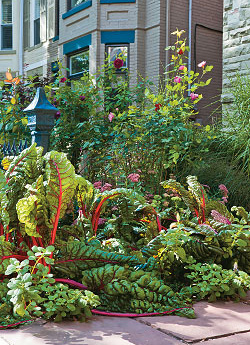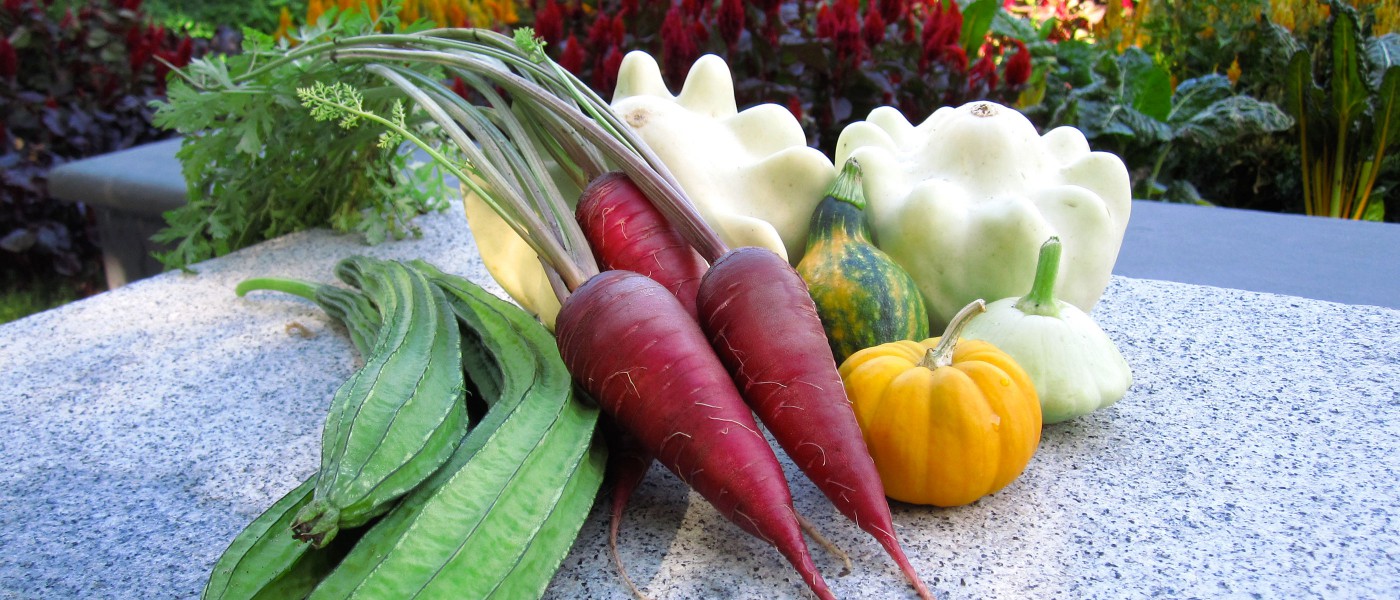Edible Gardens
- The Magic of Food Plants, by Elizabeth Peters
- Beauty and Bounty in the Garden, by Barbara Damrosch
- Edible Garden Designs
-
- A Delicious Front Yard, by Meghan Ray
- An Ornamental Potager, by Cayleb Long
- A Native Food Forest and Meadow, by Ulrich Lorimer
- A Home Orchard, by Joan McDonald
- Container Gardens, by Jennifer Williams
- A Public Garden, by Caleb Leech
- A Children's Garden, by Ashley Gamell
- Encyclopedia of Edible Garden Plants, by Joni Blackburn
- Edible Garden Plants at a Glance
- Planning your Edible Garden
- For More Information
- Contributors
- Index
Introduction
The Magic of Food Plants
Elizabeth Peters

Plants do something magical, something that forms the basis of life on our planet. When sunlight falls on them, plants use chlorophyll to trap some of the sun’s energy in the molecules that they assemble using water and carbon dioxide in the process called photosynthesis. (Most plants do this. Some are parasitic, relying on other plants’ work to survive.) Once this energy is captured, swept out of thin air and packed into new molecules called sugars, it is available to support the plant’s growth and reproduction.
Plants distribute these sugars throughout their bodies to store them near all the cells that need energy for metabolism. Some sugars are converted into more complex molecules, including amino acids and the long cellulose molecules that form a plant’s structure. Many are used to make the plant’s flowers, fruit, and seeds. And because the plant cannot control its environment, it stores excess sugars against a future time of need—literally saving for a cloudy day (or, more often, a dry one).
Animals, including us humans, can’t harvest energy directly from the sun in this manner. To get the energy we need to live, we eat plants (or animals that ate plants) and tap into the energy that was originally embodied in those sugars. In this way, we rely on plants for our own growth, movement, thinking—for our very existence. Life is solar powered.
Cultivating Plants as Food
Long ago, humans discovered some food plants to be more useful than others. We learned to avoid those that made us sick or were too tough to digest and instead sought out those with the greatest rewards: sweet, sugary fruits; starchy roots full of stored sugars; fat- and protein-rich seeds. At first we foraged for what nature offered us, migrating to follow what was seasonally available. At some point, probably over 10,000 years ago, humans began to tame and cultivate plants, and the art of agriculture began.
The earliest domesticated food plants were probably chosen for practical traits like easily collectible and storable seeds, speed of germination, and reliability of growth. Other desirable traits would have included a quick progression from seed to harvest, a bountiful reward of edible parts, and crops that could be collected over time or that would store well. These traits were favored as seeds from the most successful plants were collected and replanted over generations. Over time, this has led to forms of cultivated plants that are very different from their wild cousins.
Look through a kitchen garden seed catalog, and you will see a carnival of plants with edible parts exaggerated to the point of caricature. Carrots hoard sugars in a gigantic taproot; corn offers up an obscenely large seed head; lettuces produce a bounty of sweet leaves on the shortest stem you can imagine. Nowadays, in addition to practical considerations, we cultivate food plants for entertainment, selecting for features like taste, color, and form.
And we cultivate them for their stories. Foods embody memories, both our own personal memories (Grandma’s rhubarb pie) and our cultural memories (okra came to the South with the African slave trade). Seeing these familiar foods in an unfamiliar setting—not the grocery aisle but the garden bed—provides a great jumping-off point for talking about nature, nutrition, economics, seasonality, and more.
Edible Plants at Brooklyn Botanic Garden
With this in mind, BBG’s Herb Garden was expanded and redesigned in 2010 to offer a dynamic educational space for classes and visitors alike. Dedicated to plants grown for human use, the garden is designed to be a decorative potager, or kitchen garden, that freely mixes medicinal and culinary herbs, vegetables, berries, fruit trees, and flowers that reflect the diverse cultures and culinary traditions of Brooklyn’s neighborhoods. A central bed of annual vegetables changes with the seasons, while a small orchard and fences of espaliered and trained trees and shrubs show the production of fruit over time.
Another garden dedicated to edible plants is BBG’s Children’s Garden, where children have been growing flowers, vegetables, and herbs since 1914. Each year, over 800 children nurture and harvest their own food plants in victory garden–style plots. In the process they learn about botany, plant families, seed germination, and the seasonal cycles of nature.
Edible plants flourish in many other gardens at BBG, including the Native Flora Garden, the Annual and Perennial Borders, and the Plant Family Collection. In the pages that follow, you’ll find numerous inspirational designs for edible gardens created by BBG’s expert garden curators.
Gardening with Edible Plants
As Barbara Damrosch makes clear in the next chapter, food plants can be very rewarding in the home garden. Most edibles have been selected to be easy to grow and care for (which is one of the reasons they are so great to grow with children). Annuals offer a quick progression from seed to maturity, meaning in most cases that there will not be long to wait for their peak visual display and edible bounty, and they will change dramatically through the season. Designed to be consumable, edible annuals offer almost immediate visual gratification, after which you can harvest them and try something new—or let them bolt to see familiar plants take on forms you never dreamed of.
Herbaceous perennials return year after year, emerging dramatically from seemingly lifeless soil and, like annuals, rapidly forming vegetative parts. Fruit-bearing woody trees and shrubs may provide less drama over the growing season but offer structure and year-round visual interest in addition to fragrant spring flowers and tasty payoffs.
The plant encyclopedia that starts on page 50 profiles many of the garden-worthy options featured in this book’s sample designs and offers myriad choices for gardeners who wish to incorporate edible plants into their sites. A summary of each plant’s origins and cultural or culinary significance is followed by tips on growing, harvesting, and eating it and photographs of the plant’s aesthetic features. An “Edible Garden Plants at a Glance” chart (page 108) calls out those species that are native to North America, great for kids (or beginning gardeners of any age) to grow, or that can be productive even in sites that receive less than six hours of sun each day.
There are many books dedicated to the practice of growing edible plants. Our goal in creating this handbook was not to replicate the information contained in other references but to share some of Brooklyn Botanic Garden’s own favorite plants and the strategies we use to incorporate them into an ornamental landscape. It offers a quick reference and starting point for additional exploration. We’re sure you’ll learn something new in these pages, and hope it inspires you to grow an attractive, entertaining, and bountiful edible garden.
Purchase

